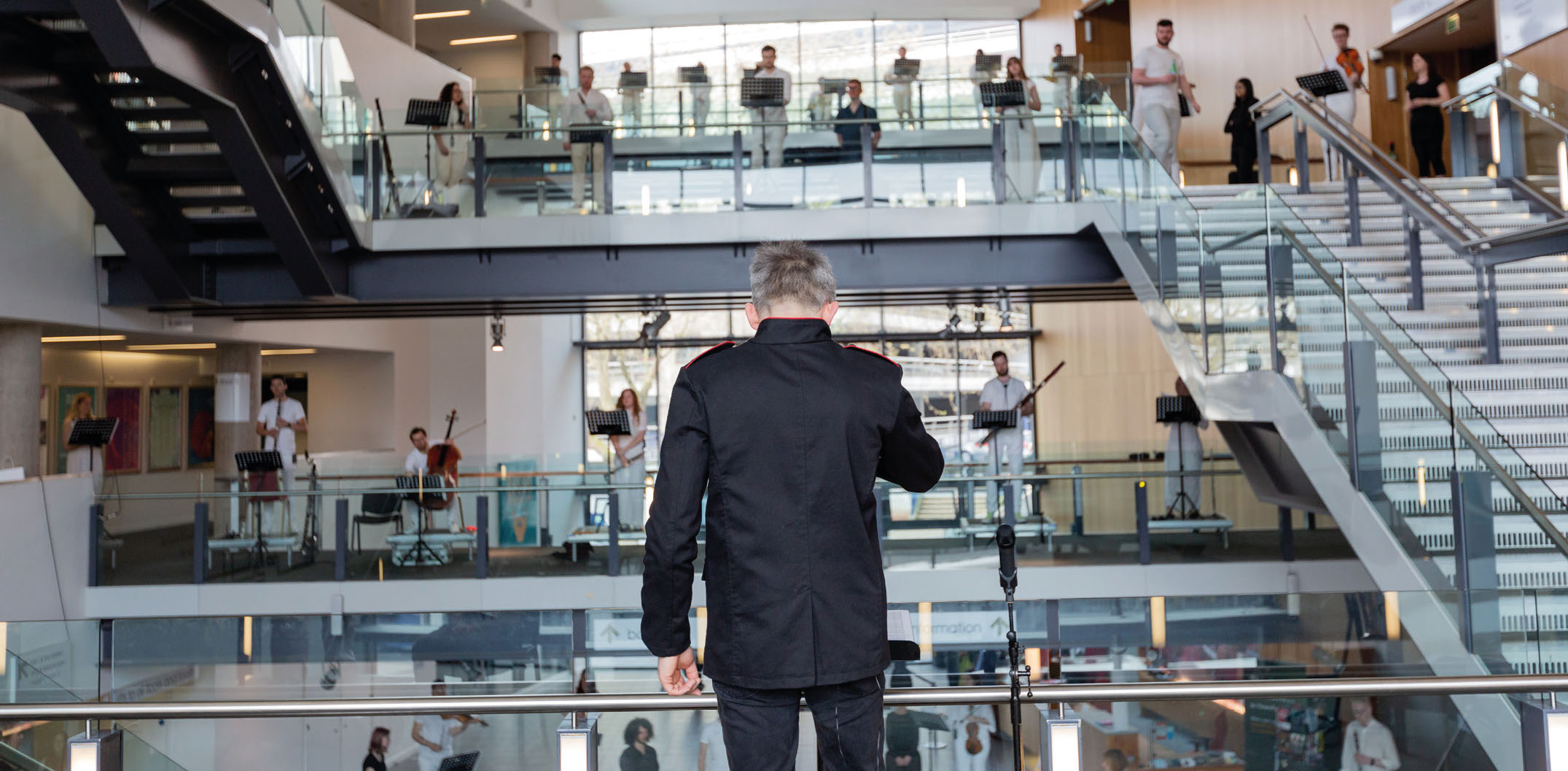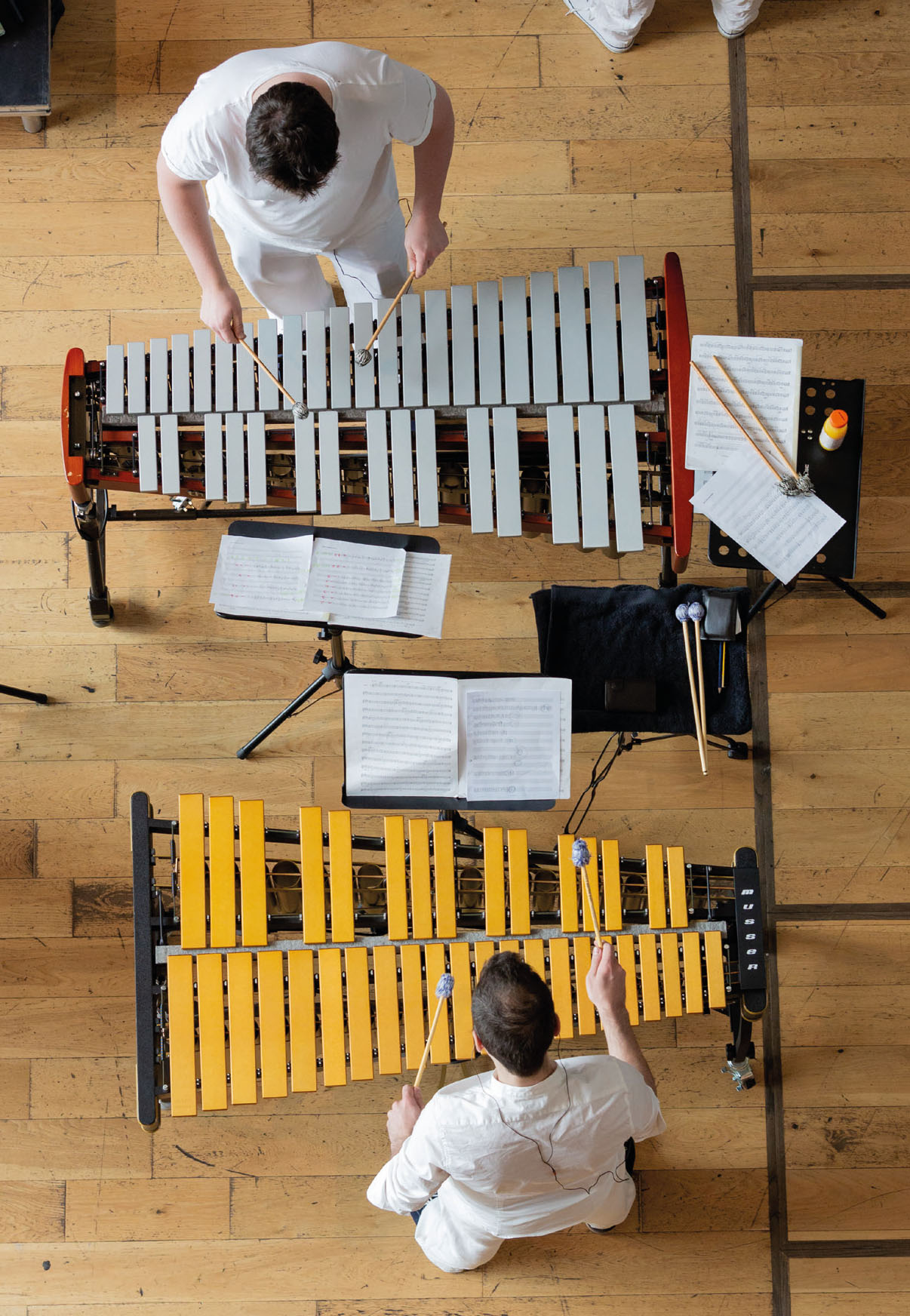
Lloyd Coleman, Paraorchestra's associate music director, was telling me what to expect from Anatomy of the Orchestra. I spoke to him a few days before Paraorchestra's sold-out performances at Bristol Beacon, and now that I was there, with brass ringing out three storeys above while grand pianos and timpani boomed from below, I understood what he meant.
Instead of the usual orchestral formation, the players were dispersed throughout the glass-fronted atrium's four open levels, mixed in with the audience. Never mind the fourth wall, I'm not sure this performance had a third or second either…
I climbed a flight of stairs, past people leaning over the edges and craning in every direction, and heard piccolo next to cello next to clarinet next to viola – ‘It's like the orchestra exploded’, I heard an audience member say.
Paraorchestra is the world's only large-scale virtuoso ensemble of professional disabled and non-disabled musicians. In Anatomy of the Orchestra, 51 players perform Steve Reich's The Four Sections while audience members of all ages are free to move around them, sit down next to them, peer at their instruments and music, and generally go wherever their curiosity leads them. Perhaps this approach could only work with minimalist music – the musicians, all in white, play unflappably while, holding everything together in the very middle of the space, Charles Hazlewood conducts.

Charles Hazlewood conducting Paraorchestra in rehearsal at Bristol Beacon in 2018 © PAUL BLAKEMORE
Force of nature
Hazlewood is known to many different audiences for many different things; you might have heard him conducting a traditional orchestral concert in the Barbican or the Concertgebouw, or while standing in a muddy festival field as he shared the stage with rappers and pop stars. He's a familiar face on BBC and Sky Arts programmes. One thing his varied work has in common is the desire to question and expand the possibilities of what an orchestra can do, both in terms of the music itself and the way audiences experience it.
Coleman has worked with Hazlewood for 10 years, since the earliest days of Paraorchestra.
‘Charles is a force of nature’, Coleman tells me. ‘I knew from early on; the way he is and the force of his personality – he's not someone who does things by halves. It was clear that he was really passionate and genuinely serious about levelling the playing field.’
One of Hazlewood's children, also a musician, has cerebral palsy, and he realised that there were very few disabled people playing in orchestras. ‘He thought, this is an injustice, this is something that I want to change’, Coleman says. ‘Indeed, 10 years later, the Paraorchestra is the majority of Charles’ activity as a musician. He's the artistic director, and conductor for many of our projects – his energy and his commitment to the cause is exactly the same today as it was 10 years ago.’
An inclusive mindset
Coleman explains the Paraorchestra approach: to treat disabled and non-disabled musicians exactly the same at the point of making music. This is not, of course, the same as treating disabled musicians exactly the same as their non-disabled counterparts full stop. Doing so would defeat the point and mean that many disabled musicians would be denied access to that very ‘point of making music’.
What does the Paraorchestra approach mean in practice? ‘It could mean a blind musician having their music sent to them a long time before the gig, very often in braille format and with audio mock-ups,’ Coleman explains. For other musicians, other software and technology plays an important role.
‘It's also a mindset – this is a priority for us, and we'll do whatever we can to address the chronic lack of representation that is currently there. We're all about giving those musicians a platform and putting them in the same spaces as their non-disabled peers. Hopefully, the more audiences see those musicians playing in those spaces, the more it becomes frankly unremarkable.’
This was evident at the show itself, where many people had gratefully snapped up tickets for a free musical performance at the end of half-term where their children were allowed to run around. ‘I was listening and wandering around and I gradually noticed that some of the musicians had disabilities,’ says audience member Kate. ‘I'd been thinking about how the musicians were making themselves very vulnerable out in the audience like that, and now I'm wondering how it is for the disabled musicians.’
‘I'll be honest,’ says Coleman, ‘The first time I did it was quite an unsettling experience for the first five or 10 minutes of the piece – it's such a different way of making music.’
 © PAUL BLAKEMORE
© PAUL BLAKEMORE
A Hogwarts for musicians
I ask him about his own music education. Coleman is a composer and clarinettist; he grew up in South Wales and his passion for music started at a young age. ‘I just remember from the earliest days, when I was five or six years old, being completely obsessed with the piano in the school hall.’
He has a hearing impairment and a visual impairment, and he told me that his musical abilities came as a surprise to his parents. ‘I used to sing nursery rhymes, which was a bit of a surprise to them because obviously my speech development was very delayed. I was picking up melodies and sound, but I wasn't able to pick up the words that went with them. So, I would sing la la la la la perfectly in tune – that's what I'm told anyway!’
Coleman's persistent curiosity about the school piano paid off and he began having lessons. ‘I was always wondering, how do you put the notes together, and how do you make something that sounds really grand and cool? From the beginning I was progressing really quickly; very soon I was making up my own pieces and it was clear to my parents that it wasn't just a passing thing.’
‘It was an obsession’, he tells me, a word he uses a lot when describing what music means to him.
After he began learning the clarinet, Coleman was able to join the local youth orchestras and bands around Bridgend. By the time he was 14, he had Grade 8 on both instruments and his non-musician parents were at a loss for what he should do next.
His family had seen local trumpeter Huw Morgan on the BBC Young Musician competition and knew that he went to a specialist music school called Chetham's. ‘I thought, yes! A Hogwarts for musicians!’ Coleman's years at Chetham's were formative. ‘I had a really fantastic clarinet teacher called Jo Patton who plays second clarinet in the CBSO [City of Birmingham Symphony Orchestra] – she was amazing at working with my hearing loss. Every week we'd have a really sensible and open discussion about how I experienced sound, and how I could use my hearing loss almost as an advantage.’
‘I realise as I get older how amazing it was that I had someone who thought in that way. I could have easily had a teacher who would have thought, “well, you can't hear half of what you're playing so I won't bother with you”. I think Jo just took a real interest and curiosity in how I experienced music and sound.’

© PAUL BLAKEMORE
Sonic perspectives
As well as obsession, curiosity is a word that Coleman uses again and again. He describes the visit of a tuba quartet to his primary school and how he experienced the sound of live music from the inside out. Hazlewood had a similar experience as a child when he was invited to sit within the orchestra at a rehearsal, and it's from these curiosity-sparking, enveloping experiences that Anatomy of the Orchestra grew.
In his introduction, simultaneously translated into British Sign Language, Hazlewood is at pains to encourage the audience to move around and get different sonic perspectives on the orchestra, and not stay planted to one spot.
‘It's great not to have to hush!’ says audience member Mary, who is pushing a baby in a pram as she listens. From a toddler glued to a grand piano to a group of friends asking the one musician among them what all the instruments were, curiosity breaks out everywhere. I spot a few music teacher colleagues – for us it is a great opportunity to reconnect with our own curiosity about sound and music, and to experience it as intensely as do those who learn with us.
Paraorchestra will be performing Anatomy of the Orchestra at the Opening Weekend of the Southbank Centre's classical season on 24 September.








